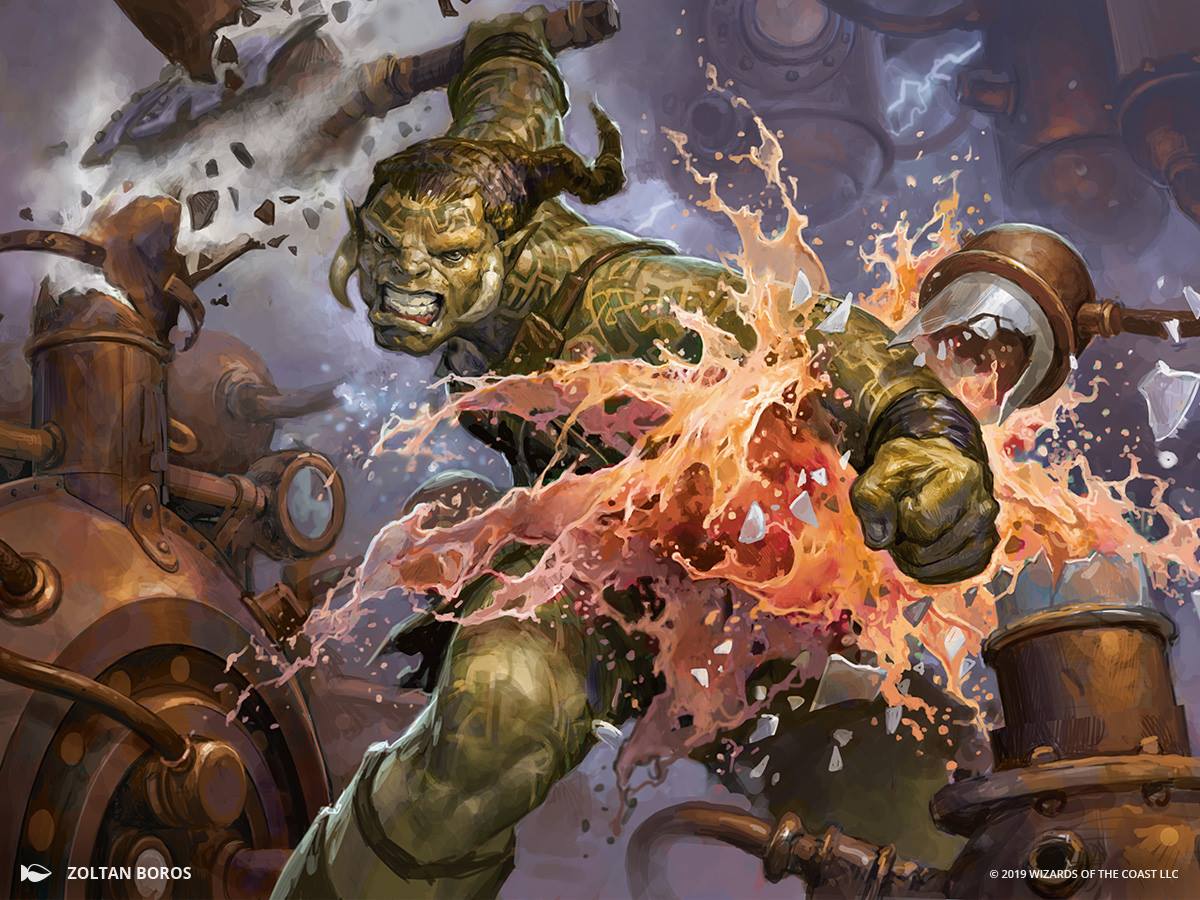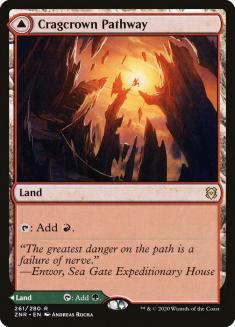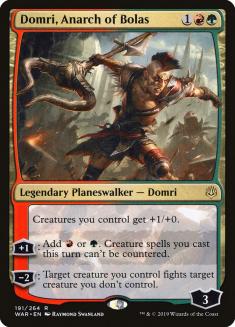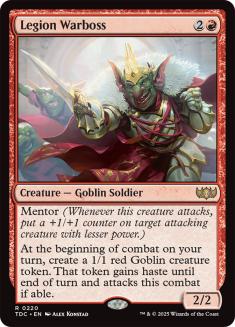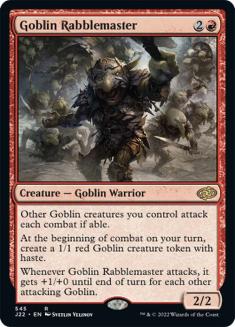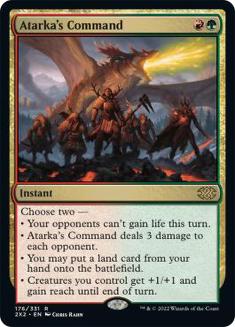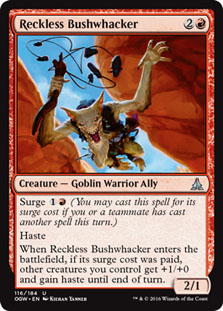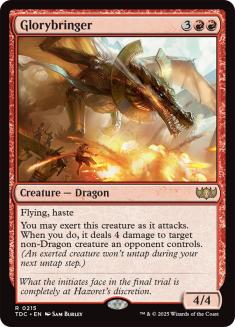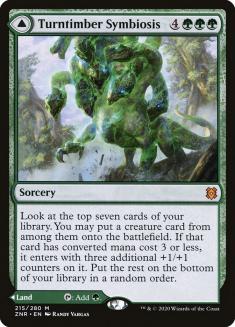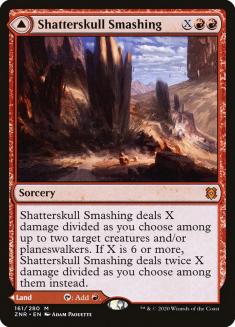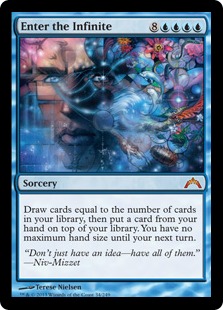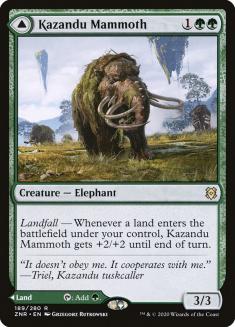Zendikar Rising is here and seems to be having a significant impact on virtually every Constructed format. The modal nature of the double-faced cards (DFC) leads to more decisions in the early turns as it pertains to sequencing, but the fact that all of them have lands as their backside means you get to actually play Magic instead of getting mana screwed every so often. The fact that most of these lands enter the battlefield tapped also slows the pace of the game down significantly. Similar to morph from previous sets, even if you can’t cast your spell, it still has some good functionality.
There’s been a grand reduction in variance as of late. With the printing of these modal DFCs, as well as the London Mulligan, most games of Magic tend to happen more or less how you drew them up. Consistency is the most important aspect of any deck, because “doing your thing” more often usually leads to victory. Where the London Mulligan homogenizes games, the modal DFCs actually create a lot of variable experiences. I would argue that the London Mulligan is actually bad for Magic in general, where the modal DFCs are fantastic.
The first thing I noticed when playing with these new cards is that you can cheat on mana significantly. I played a couple of matches with Collected Company using some of these new creatures, and I gotta say that having extra hits was really nice. I also noticed that Kanister already discovered a way to win the game by playing zero actual lands with surprising consistency, which is the natural extreme. Undercity Informer and Balustrade Spy were obviously not created with these new cards in mind, and only time will tell if they end up being a problem. The last time something like this happened, we ended up with Dimir Inverter looming over the format for roughly six months.
Pioneer was already going through some serious changes with the recent bannings, but now there should be a ton of space for exploration of new archetypes as well as innvotation inside existing ones. Today’s article will focus entirely on one of my favorite Pioneer flavors: Gruul Aggro. Why?
The Pathways are exceptional. I will crow that from the rooftops for as long as I need to. They’ve done such a great job of helping cast spells, but their true strength lies in casting spells with a light touch of your secondary or tertiary color. Unlike previous lands of this nature, they’re locked in at the beginning and can’t be changed as the game progresses. If you choose red, you aren’t casting that Yorvo, Lord of Garenbrig for a while.
Like Copperline Gorge before them, Cragcrown Pathway and its ilk are better-suited for aggressive decks because they allow you to have either color without entering the battlefield tapped. Multicolor lands tend to have some significant drawback, but these allow for spreading out your colors in the early turns without putting you at a significant disadvantage. Allied color combinations in Pioneer have been lacking in the two-color land department, as both Karplusan Forest and Copperline Gorge are currently missing. These two land cycles were expected to be finished at some point, giving a bit more consistency to Gruul and Selesnya, but the Pathways are a fine replacement for now.
The biggest draw of Cragcrown Pathway is that it easily casts Llanowar Elves on the first turn while giving you another untapped multicolor land for the three-drop you’re accelerating into. Golgari and Simic (or even Mono-Green) were the preferred Llanowar Elves decks as they provided smoother openers thanks to Blooming Marsh and Botanical Sanctum. Mana Confluence was suitable but dangerous if the metagame was too hostile. Pathways are a bit worse for three-color decks, but still incredible. They also don’t punish you like the Botanical Sanctum cycle as the game progresses.
They might be among the Top 5 land cycles ever printed.
What I’m absolutely certain of is that these lands will reshape multiple different archetypes in Pioneer, including Gruul Aggro.
Creatures (32)
- 4 Llanowar Elves
- 4 Burning-Tree Emissary
- 4 Elvish Mystic
- 4 Goblin Rabblemaster
- 4 Reckless Bushwhacker
- 4 Legion Warboss
- 4 Bonecrusher Giant
- 4 Kazandu Mammoth
Planeswalkers (3)
Lands (21)
Spells (4)

A version of this deck won the first Pioneer Challenge on Magic Online (MTGO), though this build is significantly different. The addition of Cragcrown Pathway creates incentive to go hard and fast, which we’re pushing about as hard as we can. Four copies of Mana Confluence to accompany Stomping Ground and Cragcrown Pathway should alleviate most of our color concerns in the early turns, leading to more explosive draws that aren’t hindered by mana woes.
One huge upgrade for the deck is Domri, Anarch of Bolas. This planeswalker is rarely used, though my experience with it has been largely positive. Pumping all of your creatures as the static effect means your early mana creatures are actual threats. There is little more frustrating for an aggro deck than to flood out, so anything that helps boost Llanowar Elves to “rumble” status is good in my book.
All of its abilities are significant, but the best pairing has to be one of the Goblin lords.
The Goblin Bros are potent, ending games where your opponent stumbles with frightening consistency and speed. On the play, an Elf into Goblin draw is so threatening that most decks will fold without a piece of cheap removal or three-mana sweeper. Goblin Rabblemaster in particular hits incredibly hard, and is probably the better of the two, but both are similar enough and good enough that they should get the job done.
The Cragcrown Pathway addition makes these look even better because they’re outrageously powerful but only cost one red mana. If they were 1RR, they probably wouldn’t even work in this archetype because they’d be much more difficult to land early with Llanowar Elves. Because we don’t live in a fetchland world, we don’t have perfect mana. Our mana creatures are also relatively limited, as we don’t have Birds of Paradise.
All this is just to say The Goblin Bros are probably your best option for the slot. While you could go hard with the big green baddies like Yorvo or Steel Leaf Champion, those are significantly more vulnerable to spot removal. The Goblin Bros leaving behind a Goblin (usually) helps you create additional pressure without adding another creature to the battlefield. While it might just be a 1/1, every little threat tends to add up. Combined with Atarka’s Command or Domri, Anarch of Bolas, those little 1/1s start to look a little juicier.
These two burst-damage spells give you crazy-fast kills that most decks can’t realistically handle. I’m hoping the consistency of the lands allows these two-damage generators to reach their full potential. Both can be mediocre if you’re on a low-resource draw due to mulligans or sweepers, but their closing speed when you’re ahead is virtually unmatched. Alongside Burning-Tree Emissary and a host of mana creatures, any spell that makes those bodies better is much-wanted.
The added ability of Atarka’s Command to generate extra virtual damage in the face of Uro or other methods of gaining life is an added bonus. If the only modes were “buff your creatures” and “deal three damage to the opponent,” it would still be a great card that sees about as much play as it currently does. No one should care much about the Skullcrack part of it. Instead, consider it a nice bonus on an already good card.
To note, I do sideboard out Atarka’s Command more than any other card. It gets significantly worse after sideboard because most decks become more interactive. Atarka’s Command is stronger when both players are just doing their own thing, trying to goldfish kills. After sideboard, that’s almost never the case. I also try to keep my threat density up pretty high, so sideboarding out a noncreature spell when I sideboard in removal like Redcap Melee just makes sense.
Reckless Bushwhacker isn’t at its full potential here, but it’s still pretty solid. I’d say that any deck that plays red mana and uses Burning-Tree Emissary should consider Reckless Bushwhacker. It’s an absurd effect that generates a ton of damage. It probably pairs best with a host of one-mana creatures in an aggressively slanted deck. While this one is certainly aggressive, the downside of playing creatures like Llanowar Elves is that they’re notoriously difficult to attack with. I’m hoping that the combination of all of our burst damage effects makes their bodies just as relevant as their ability to produce mana.
This version is pretty low to the ground, and there are many other ways to build Gruul Aggro. Let’s try something a little bigger.
Creatures (24)
- 4 Llanowar Elves
- 4 Elvish Mystic
- 4 Goblin Rabblemaster
- 4 Glorybringer
- 4 Legion Warboss
- 4 Bonecrusher Giant
Planeswalkers (6)
Lands (22)
Spells (8)
Sideboard

Like the previous list, we’re somewhat reliant on the Goblin Bros to do a lot of heavy lifting. This version makes better use of Domri, Anarch of Bolas, as the mana generation can be used in many different ways. Since we’re ramping up the costs a bit, the curve of Llanowar Elves into Domri allows for some bangers.
This is the main reason to get Chonky. We’re going a bit bigger to have a slightly better matchup against other aggro decks. Cheap removal isn’t nearly as detrimental because our creatures are better as standalone threats. We are slightly more vulnerable to spot removal on our Elves, but our late-game is significantly better than in the Aggro iteration.
If the format boils down to being very creature-centric, this will be my go-to. Glorybringer is king when everyone is playing fair, and we have some of the best and fastest Glorybringer draws in the business. Imagine trying to beat Elf-Domri-Glorybringer when you’re on the draw. It just feels impossible!
These spells are definitely worth their mythic rare status. At first, I didn’t really get it. I thought they’d be relatively weak at being cast, but that was before I played my first DFC creature as a tapped land. Having that land able to enter the battlefield untapped, or be an outrageously powerful topdeck instead of a land, is something to behold. Even the blue one is pretty good (sorry I doubted you, Shaheen)!
Turntimber Symbiosis isn’t going to make any waves. Most of the time you’re just going to find a Glorybringer or a big Goblin Rabblemaster, but that’s good enough for a card that’s usually a Forest. There’s a good chance I should just be maxing out on Shatterskull Smashing instead since it scales so well with our Elves and Domri. This deck can flood out on occasion, so having a few cards that get better when you draw three or four Elves is pretty sick. Shatterskull Smashing also clears blockers quite nicely so the Goblin Bros can rumble in unimpeded.
It’s hard to put into words just how interesting a modal DFC card can be when the choice is a land or spell. It makes building your manabase a bit more difficult, but it alleviates so much pressure during the actual games. As long as you can get some value at multiple points in the game from your modal spells, you should be able to navigate your way to various spots where they’re most useful. In this deck, I think these two are significantly better than they should be, if only because it’s so important that your lands enter the battlefield untapped. Their special ability to do so, as compared to the other DFCs, makes them superior in a deck where pace of play matters more than anything else.
Last but not least:
I haven’t gotten to play with it much, but older versions of Gruul Possibility Storm suffered from the same woes as other Gruul decks: bad mana. Having better lands to cast your spells on time might make all the difference. Cragcrown Pathway opens up the door a bit, giving you more lands that produce red while still supporting a first-turn Llanowar Elves. Here’s the build.
Creatures (29)
- 4 Llanowar Elves
- 1 Borborygmos Enraged
- 4 Elvish Mystic
- 4 Glorybringer
- 4 Lovestruck Beast
- 3 Rosethorn Acolyte
- 4 Bonecrusher Giant
- 1 Stonecoil Serpent
- 4 Kazandu Mammoth
Planeswalkers (3)
Lands (22)
Spells (6)

Possibility Storm might seem like a meme deck, but let me assure you that it’s the real deal. Most of the time your games will play out like a normal Gruul Aggro deck. It’s not like Lovestruck Beast and Bonecrusher Giant are bad cards by themselves. However, when you draw your enchantment, Possibility Storm, any Adventure creature usually results in a win. The ramp necessary to cast Possibility Storm isn’t too strenuous either.
The only downside is actually drawing your money spell:
If you draw this one, all bets are off. As Ross Merriam will tell you, drawing your Progenitus in your Natural Order deck is pretty horrible, but it’s powerful all the same. Like any combo deck, your synergy is derived from assembling some combos. If you draw some errant combo pieces, your aggro deck might just fall apart! Without something like Brainstorm, there’s not a lot you can do but chalk it up to bad luck.
This one is obviously a little experimental, but my gut says it will go well in more midrange decks that want to hit more land drops. Additionally, having extra lands in case of emergency is huge. We can’t play Turntimber Symbiosis here because it counts for Possibility Storm, but I think Kazandu Mammoth hits hard enough to warrant the inclusion. I considered Tangled Florahedron as a ramp spell that doubled as that extra land, but I think you want to keep the aggressive slant. Kazandu Mammoth does exactly that.
Gruul Aggro got a lot better with the addition of Cragcrown Pathway, opening up different builds across multiple formats. Any deck that wants to go Llanowar Elves into a red three-drop wants it. Mana is often the most important part of any deck. Imagine a world where Stomping Ground didn’t exist yet. I lived through that. The Ravnica shockland cycle was revolutionary for deckbuilding. The Pathway lands are in the same ballpark, which is simply incredible at this stage in Magic’s development.
They really knocked it out of the park with the modal DFCs and I’m itching to get some more Leagues in. I feel like we’ve barely scratched the surface on their playability. There’s so much space between “bad Forest” and “bad Prey Upon” that combining the two just seems pretty cool. Modal spells like Izzet Charm have always made me giddy, even if they’re a little inefficient for the effect they grant. Having the option to turn you bad spell into a land or your bad land into a functional/good spell is groundbreaking territory.
And lastly, a preemptive good riddance Uro, Titan of Nature’s Wrath. No one likes you and no one wants you around. Get out of every format forever. You and Oko deserve each other.

